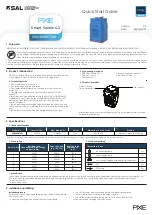
IM_ONE_Safety-07
www.ueonline.com
4
Mount the device using the four (4) 1/4” clearance holes in the enclosure base. Plumb sensor to the process port. See page 20-21 for dimensions.
The device may be mounted in any position except with the sensor connection facing up. Ensure the process connection is sealed to the process
port to prevent leakage. Care should be taken to minimize effects of shock and vibration. The One Series should be protected from direct sunlight
and rain in outdoor installations using a shroud (user supplied).
NOTE
: the optimal display viewing position is 6:00.
FOR PRESSURE AND LOCAL TEMPERATURE MODELS ALWAYS HOLD A WRENCH ON THE SENSOR HOUSING HEX WHEN MOUNTING DEVICE. DO
NOT TIGHTEN BY TURNING ENCLOSURE, THIS WILL DAMAGE THE CONNECTION BETWEEN THE SENSOR AND HOUSING.
FOR DIFFERENTIAL PRESSURE MODELS (ESPECIALLY LOW RANGE MODELS), MOUNT THE SENSOR LEVEL TO MINIMIZE ANY PRESSURE
READING OFFSETS. THE OFFSET COMMAND MAY BE USED TO ZERO THE DISPLAY, (SEE PAGE 13 FOR ADDITIONAL INFORMATION).
PROCESS CONNECTIONS AND SENSOR INSTALLATION
NEVER INSERT ANY OBJECT INTO THE PRESSURE SENSOR OPENING. DAMAGE TO THE SENSOR WILL RESULT, AFFECTING ACCURACY.
Pressure and Differential Pressure Models
To pipe mount: Thread the pressure connection onto the pressure port, with thread sealant, making sure that the mating threads are clean and
free of debris. Use a wrench on the pressure connection hex to tighten. Test for leaks. On Differential Pressure models, the Low (L) side pressure
must NOT exceed the high (H) side pressure. Damage to the sensor may result.
Local and Remote Temperature Models
For Local Ambient Sensing (model L): Mount using the mounting holes on the electronics housing. Mount the device to ensure that the sensor
housing will not be damaged and where the measured temperature is representative of the surrounding environment.
For Local Spring-Loaded (model T): A suitable thermowell, made from corrosion-resistant material, 5 threads engaged minimum, with thread
sealant, is required to maintain enclosure type 4X/IP66.
For Remote Sensing: Route the extension wire to avoid contact with live components or close proximity to electrical noise sources. Avoid kinks, or
excessive flexing. Tighten the ferrule fitting, if applicable.
For Surface Sensing: Secure the sensor housing to the pipe or vessel using an adhesive or strapping method suitable for the application.
For Immersion Sensing (models C, H, R & L): Use of a thermowell is highly recommended to aid in maintenance, testing and preservation of the
system integrity.
For existing thermowells with 0.375” bore, an insert is available from UE as part number 62169-44 (see Figure 2). The adapter provides a
faster heat transfer by adapting the 0.250” diameter temperature sensor housing to a larger bore 0.375” thermowell. Heat transfer compound is recommended
in the bottom of the well and inside the adapter opening.
Insert the sensor housing (0.25” diameter) into the well ensuring that the sensor’s sheath bottoms out and the well is completely immersed in
the media (2.5” min.) Screw the sensor’s nipple into the thermowell, with thread sealant, by placing a wrench on the union nut. Tighten the union
connector.
For best temperature measurements, the sensor housing must be in full contact with the surface or media being measured. Heat transfer compound
may be used to aid in fully transferring the media temperature to the sensor housing. Locate where the temperature is most representative of the
system. Minimum insertion depth is 2-1/2”. Sensor dimensional drawings are shown on page 21.
0.375 REF
0.250
REF
2.50
REF
SENSOR
THERMOWELL ADAPTER
[6.35] mm
[63.5] mm
[9.53] mm
Figure 2





































